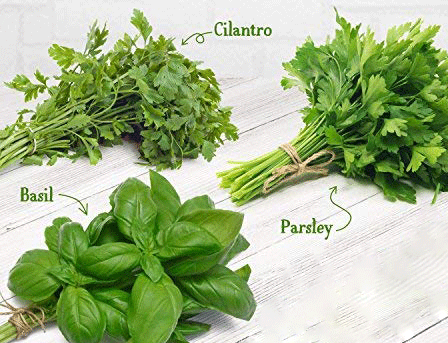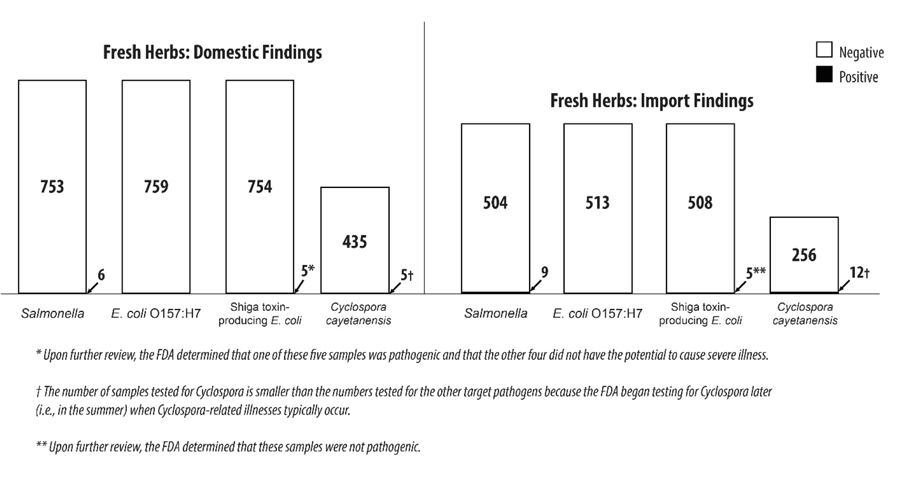Microbiological Surveillance Sampling: FY18-21 Fresh Herbs (Cilantro, Basil & Parsley) and Processed Avocado and Guacamole Assignments
<< Microbiological Surveillance Sampling
Fresh Herbs (Cilantro, Parsley & Basil)
Fresh cilantro, parsley and basil are typically eaten without having undergone a ‘kill step,’ such as cooking, to reduce or eliminate bacteria. These herbs are grown low to the ground and therefore are susceptible to contamination (e.g., from irrigation water splashing off the soil).
From 1996 to 2015, the FDA reported nine outbreaks linked to basil, parsley and cilantro, which resulted in 2,699 illnesses and 84 hospitalizations. Four of the outbreaks were linked to basil, three to cilantro, and two to parsley. Of those same nine outbreaks, seven were attributed to Cyclospora cayetanensis; one was attributed to E. coli O157:H7; and one was attributed to Shigella sonnei. The FDA is seeking to obtain baseline estimates of the prevalence of Salmonella and Shiga toxin-producing E. coli (STEC) in cilantro, basil and parsley.
In addition, given that Cyclospora-related illnesses typically occur in the summer, the FDA began testing fresh herb samples for Cyclospora cayetanensis in July 2018 to estimate the prevalence of that microorganism in basil, parsley and cilantro. Surveillance sampling is an important tool that the FDA and the Centers for Disease Control and Prevention (CDC) are using as one part of a robust strategy to prevent illnesses caused by Cyclospora. Read more on cyclosporiasis and fresh produce.
Processed Avocado & Guacamole
Avocados have a high lipid and moisture content, low carbohydrates, and non-acidic pH level, which can make them a favorable growth medium for harmful bacteria. Processed avocado products, including avocado that is fresh cut, refrigerated and frozen, may be packaged and eaten without having undergone a ‘kill step’ prior to consumption. In addition, processing fresh produce into fresh-cut products increases the risk of bacterial growth by breaking the fruit’s skin and allowing for the spread and potential growth of any pathogens that may be present.
According to the CDC, there were 12 outbreaks of foodborne illness related to avocado, avocado products or guacamole products from 2005 to 2015. Of those 12 outbreaks, nine involved Salmonella and three involved E. coli, resulting in 525 illnesses and 23 hospitalizations in all. Though no listeriosis outbreaks were reported in connection with avocados from 2005 to 2015, a recent sampling assignment by the FDA detected Listeria monocytogenes in samples collected from the fruit’s pulp and skin.
The agency is seeking data on the prevalence of Salmonella and Listeria monocytogenes in processed avocado and processed avocado products.
Questions and Answers
The FDA began collecting and testing fresh herbs (cilantro, parsley and basil) and processed avocado and guacamole in October 2017. These two assignments were anticipated to last about two years. The agency paused its fresh herbs sampling in the spring of 2020 in light of the coronavirus (COVID-19) pandemic. As of January 12, 2021, the FDA has resumed its fresh herbs assignment and anticipates completing it this spring. Sample collection and testing ended in fall 2019 for the processed avocado and guacamole assignment.
See “Results” section below for the status of sample collection for each assignment.
The FDA is collecting samples of imported fresh cilantro and parsley from ports of entry, importer warehouses, or other storage facilities where foreign goods are cleared for entry into the country. The FDA ceased collecting domestic samples of fresh herbs in 2020, having achieved a sufficient number for analytical purposes. The agency collected its domestic samples from packers (including post-harvest products in packinghouses on farms), wholesalers, distributors/warehouses and retail locations. Retail samples were collected from dealer refrigerated storage prior to consumer handling.
The FDA collected samples of imported processed avocado and guacamole from ports of entry, importer warehouses, or other storage facilities, and domestic samples from processors, distributors and retail locations.
In the fresh herbs assignment, the FDA is collecting fresh, raw parsley and cilantro. The agency also collected fresh basil under this assignment but ceased doing so in 2020 after achieving its numerical target for that herb type. The agency is not collecting frozen, chopped, or dried herbs, or fresh herbs indicated as intended for processing.
In the avocado assignment, the FDA collected processed avocado, including fresh cut, pureed, refrigerated and frozen product, as well as frozen avocado pulp with additives, and guacamole.
The FDA is testing the fresh herb samples for Salmonella and STEC. The FDA also began testing the fresh herb samples for Cyclospora cayetanensis in July 2018 given that Cyclospora-related illnesses typically occur in the summer. The FDA developed and in 2017 published an analytical method for the detection of the parasite in fresh produce.
In the avocado assignment, for which the sample collection and testing has been completed, the FDA tested processed avocado and guacamole for Salmonella and Listeria monocytogenes.
The FDA also is conducting whole genome sequence testing on any samples that test positive to obtain the genetic ‘fingerprint’ of the pathogen and will add the resulting information to the databases used to match human illnesses with potential food sources.
Per standard FDA practice, the agency will not provide pre-notification to firms prior to collecting samples, except if the sample collection is to occur at a packinghouse located on a farm. (All fresh herb sample collection is to occur after the produce has been harvested.) When a member of the FDA field staff is planning to collect fresh herb samples from an on-farm packinghouse, the agency employee will call the farm at least 24 hours in advance to notify the owners or operators. Sampling is a routine and critical activity that the FDA is authorized to conduct as part of its charge to ensure the safety of the food supply.
When the FDA detects a positive sample, the agency will notify the firm of the findings and work with the firm to take appropriate action to protect the public health. Enforcement activities include actions to correct and prevent violations and to remove violative food from the market, as appropriate.
See detailed information on what to expect when the FDA collects samples.
The FDA plans to publish the test results on a quarterly basis and a summary report after sampling concludes and the final data are analyzed. Check here as they will be posted at the bottom of this page.
The FDA is sensitive to the concerns of both domestic firms and importers and strives to provide analytical results to industry as soon as they are available. The FDA will notify all firms of analytical results as soon as possible once sample analysis is complete.
Results
The FDA began collecting and testing fresh herbs (cilantro, parsley and basil) and processed avocado and guacamole in October 2017. These two assignments were anticipated to last about two years. The information that follows presents the laboratory results through March 31, 2020 (with respect to the fresh herb samples) and through October 15, 2019 (with respect to the processed avocado and guacamole samples), as interim figures subject to potential revision. As noted above, the FDA paused its fresh herbs sampling in light of the COVID-19 pandemic and has resumed the assignment as of January 12, 2021. With respect to the agency’s processed avocado and guacamole assignment, sample collection and testing was ended in the fall of 2019. The FDA will publish summary reports of its results (to include final figures and breakdowns of its findings) once the assignments and related analyses have been completed. The FDA is currently analyzing the data from the processed avocado and guacamole assignment to prepare the summary report. Consumers who wish to see an example report on the FDA’s food product surveillance sampling can view any of the agency’s summary reports listed at the bottom of its microbiological surveillance sampling page.
The sampling design for each food represents what U.S. consumers are likely to find in the marketplace with respect to product origin (i.e., domestic vs. import). Accordingly, the FDA has considered the volume of the target food that is imported and produced domestically, and which countries produce and export the food to the United States. The FDA may adjust the number of samples to be collected or the collection timeline based on factors that the agency may encounter during the assignments.
In the event that samples are found to be positive for microbial hazards, the FDA will consider regulatory and enforcement options, which include: encouraging a voluntary recall or market withdrawal, ordering a mandatory recall, ordering administrative detention to prevent food from being distributed, issuing public warnings to alert consumers to the potential danger, and in the case of imported products, refusing their entry into the country and subjecting future shipments to an import alert. The agency will detail any enforcement action it takes in its summary report(s).
Fresh Herbs Results as of 4/1/2020
The FDA plans to collect 1,600 fresh herbs samples (761 domestic, and 839 of international origin) under this assignment. As of March 31, 2020, the agency had collected and tested 759 domestic samples (99.7 percent) and 513 import samples (61 percent) of the total planned samples. The following figures summarize the interim sampling results. As the testing is still underway, no conclusions can be drawn at this time.
Processed Avocado and Guacamole Results as of 10/15/2019
The FDA initially planned to collect 1,600 processed avocado and guacamole samples (800 domestic, and 800 of international origin) under this assignment. In July 2018, the FDA adjusted its collection target to 1,200 samples (936 domestic, and 264 of international origin) after initial sampling confirmed that a relatively small number of firms produce and/or distribute processed avocado. The agency’s intent was to avoid biasing the data by oversampling product from the same firms and to minimize the burden on industry. Further, the FDA learned that an increasing number of processors have begun to use high pressure processing, which is a kill step. In March 2019, the FDA further reduced its collection target to 1,056 samples (824 domestic, and 232 of international origin) given the 35-day lapse in appropriations that began on December 22, 2018, and the associated impact on the workload of the agency’s field staff.
The FDA has stopped its collection of processed avocado and guacamole samples, coinciding with the close of FY2019. The final collection total is 887 samples (777 domestic, and 110 import). The final collection total, as compared to the original target, will increase the margin of error of the prevalence estimate from 0.5 percent to approximately 0.65 percent. The FDA is completing its analyses of the data; final figures and a breakdown of the findings will be included in the forthcoming summary report.
Additional Information



